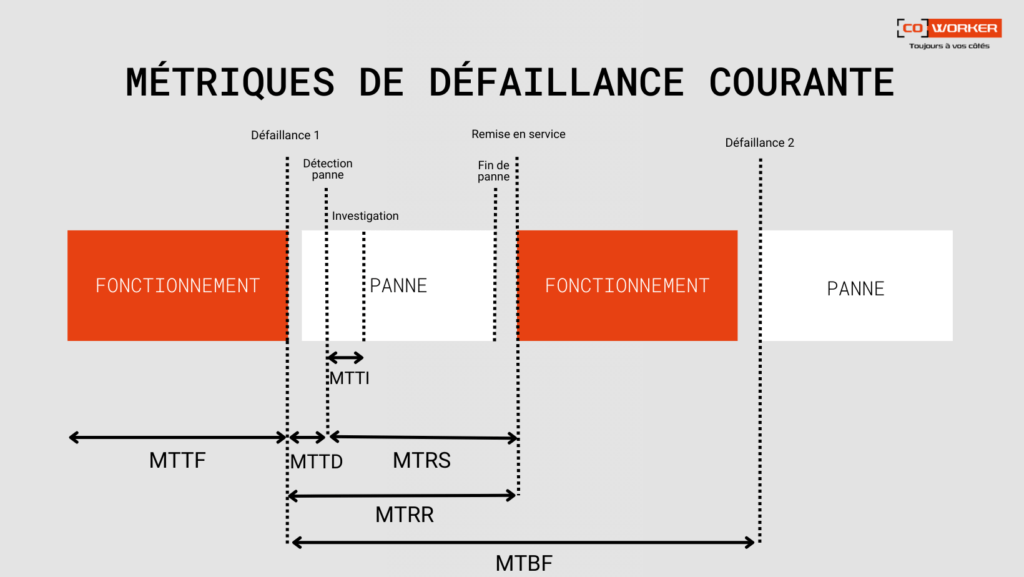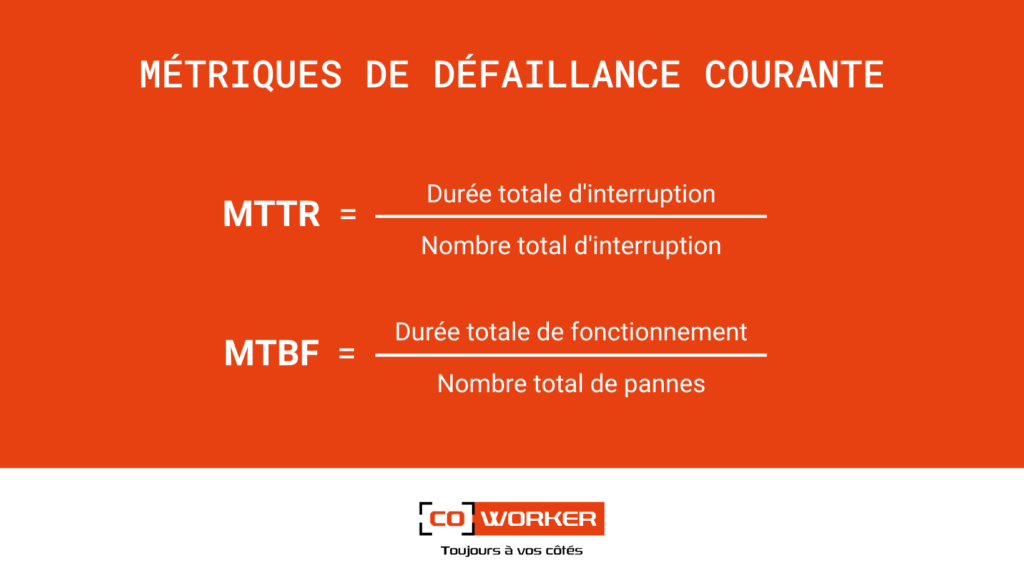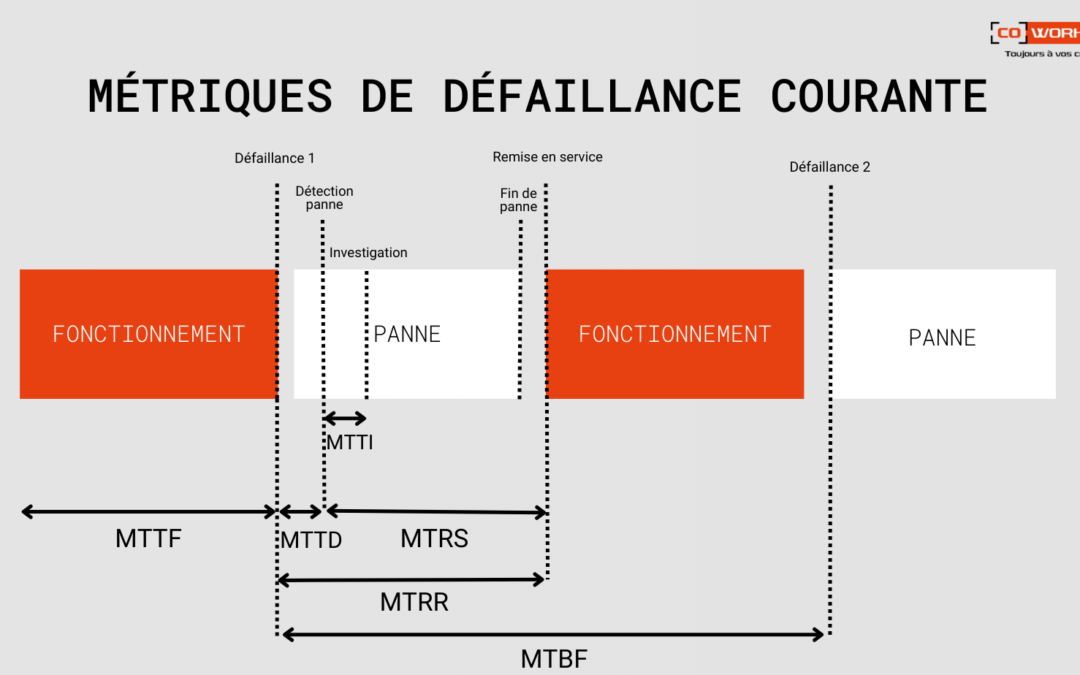What is the MTTR ?
What is the MTTR ? For the beginning, the MTTR, “Mean Time To Repair”, is an essential indicator of a manufacturer’s understanding of a production tool. This represents the average time to repair
and restore a system functionality.
Thus, the MTTR indicates among other thing simplicity of the maintenance of a company’s production equipment, but also applies to applications and infrastructure, thus of the correction in
case of computer incident efficacy.
These indicators start from the moment a failure is detected and integrate the diagnosis time, of reparation, test. All the other activities that make the service available to end users must be also
be considered.
According to ZK Research, 90% of MTTR is devoted to simply determining if there is really a problem. A diagnostic error or improper repair can also extend the MTTR.
Most of the service level agreements include a form of MTTR.
It is essential to understand that MTTR is a repair time “type” and no a guarantee. The manufacturers who display MTTR show the time that it usually requires to perform a reparation, but systematically sate that they do not guarantee it.
According to the context where it is used, the MTTR indicator can also designate the average time to return to service. In all cases, the terms represent the average time required to troubleshoot and correct an issue.
How to measure the MTTR ?
The indicator to measure the MTTR
- The failure : performance indicator allows the production structure to monitor the reliability of its machines and systems.
- The common assistance request : such as troubleshooting an industrial tablet, can have a serious impact. The “failure” doesn’t designate only non-functional devices or systems, it
applies also to the systems that operate in degraded mode. - All system who do not achieve its objectives can be considered as failing.
We count several common failure metrics :
- Mean repair time : represents the mean time required to repair and restore a failed system.
The MTTR maintenance indicator can measure in minutes, in hours, or days. (It can also designate the average restoration time or average resolution time.)
- Mean time between failure (MTBF) : often associated with the MTTR, is the average operational time between equipment failure. The companies frequently used MTBF as a predictive indicator of equipment maintenance. It is calculated by following the elapsed time between two failure, a system or component during the operation.
- Mean time to failure (MTTF) : is the average duration during which the device or system is supposed to work before to suffering a service interruption. Frequently, the specialists IT collect this data by observing the system for serial days or weeks. If it is similar at MTBF, MTTF is normally employee to plan spare parts to be owned or redundant for anticipation purposes.
- Mean time to detect (MTTD) : keystone of MTTR, it is the average time that elapses between the triggering of the problem and the moment when the company detects it. It describes the times between the moment where the IT receives a ticket and starts the MTTR counter.
- Mean time to investigation (MTTI) : average time between the detection of an incident IT a time when the organization begins to investigate its causes and resolution. It describes the time that elapses between the MTTD and the beginning of MTTR.
- Mean time recovery service (MTRS) : average time that elapses between the detection of an incident and the time the affected system or component is made available to users.
- Means time between service incidents (MTBSI) : average time that elapses between the detection of two incident consecutive. It is calculated by adding the MTBF and the MTRS (MTBSI = MTBF + MTRS).
- Default rate : other reliability indicator, who measures the frequency to which a device. It is expressed as a number of failures over a unit of time.
To be effective, failure metrics, require collecting a large amount of data. It must be said that this task can be tedious if it is done manually, fortunately the use of solutions such as MDM facilitate the collect the data needed to calculate the metrics.

The MTTR for the maintenance
The calculation of the MTTR, allows measuring clearly the duration during which of strategic production systems are out of service. This is an important maintenance indicator of the impact that an incident IT will have on the production, so on the company’s result. The bottom line, is that the higher the MTTR of an IT team, the more likely the company run the risk to undergo a major cut in case of an incident with all the consequences that follow.
Difference between the MTBF and the MTTR :
The first indicates to which frequency they equipment breaks down, while the second one shows her how fast she can put it back into service. However, these maintenance indicators can be used
together to calculate system availability. Strategically, it is necessary at the same time to reduce the MTTR and increase the MTBF to minimize or avoid the unplanned interruptions.
Méthode de calcul du MTTR :
It is done by divining the total duration of the interruption by the total numbers of interruptions. For example, when a system undergoes an interruption of service 4 times in the same month and that these failures resulted in 8 hours of downtime, so the result of this MTTR calculate is 2 hours.
MTTR formula = 8 hours / 4 interruptions = 2 hours
Method of calculating the MTBF :
The MTBF (Mean Times Between Failures), indicator allows obtaining a prediction of the rentability and availability of an equipment and its components, the formula is as fowling :
Sum of operating time dividing by the number of breakdowns.
Formula the MTBF = 8 hours / 2 interruption = 4 hours

Interpretation and application of the MTTR
When it is weak, the MTTR indicates that a product or a service can be fixed quickly, so any associated IT informatics problem are likely to have little impact on the company.
When it is high, it should prompt IT administrators and production managers to be re-evaluated their approach to troubleshooting by taking into account the life cycle, monitoring and the diagnostic method, with the aims of reducing potential interruptions.
How to reduce the MTTR ?
While most of the issues that lead to an increase are specific to each company, there are few
steps that will help almost any type of company improve their MTTR.
- Understanding incidents : to reduce it, it is necessary to understand the incidents and failures. The audit reports can help you to unite automatically your data in silos to get a maintenance indicator, reliable and precious information on the causes and drivers of this strategic metric.
- Supervision : to improve metrics and correct a difficulty, it must be identified. The sooner, the better. A great UDM (Unified Device Management) solution will provide you with a continuous stream of data on your system performance, generally within the same easy-to-read dashboard, and will notify you the onset of problems.
- The action process : use cross-functional collaborative tools to provide a specific answer to each incident. In all cases, it should clearly indicate who should be notified in the event of an incident, how it should be documented, and the procedure your team should follow to resolve it.
- Incident management : responding quickly requires, the right people, accurate information about the difficulty. An automatic management system of incident can send simultaneously alert on serial communication channels to the interlocutors clearly identified. These automatizations allow to improve the communication factor as an integral part of MTTR measurement metrics.
- Equip, skills and roles : the roles, skills, and responsibilities well established allow you to manage efficiently incident response and reduce the MTTR. The structure of the organization depends, of course, on the size of the company and its intrinsic competencies. In the case of a subcontracting, the choice of the provider needs to be verified the competence, particularly in the knowledge of the ITIL (Information Technology Infrastructure Library). Internal or outsourced it must integrate :
- An incident manger : these roles lead the incident management process, adapts and improves it as needed. These roles are generally entrusted to the assistance service manager in small and medium-size companies. Also, he leads the intervention team. He
presents the MTTR, to direction and manages the assistance of level 1 and 2.
- An incident manger : these roles lead the incident management process, adapts and improves it as needed. These roles are generally entrusted to the assistance service manager in small and medium-size companies. Also, he leads the intervention team. He
-
-
- Level 1 : this role is the single point of contact for the end users reporting incidents. It
classifies the incidents and shall endeavor to restore the failed service as soon as possible. - Level 2 : second level technicians are more specialized. They are mobilized for accidents that are not within the technical scope of level 1. Also, they are responsible for interacting with
third-party suppliers to speed up recovery services. The more complex the infrastructure and the greater the number of levels.
- Level 1 : this role is the single point of contact for the end users reporting incidents. It
-
- The training : highly targeted knowledge is the key to the proper functioning of teams, as IT is constantly evolving, and training plans have a strategic role to play.
The MTTR impact, a priority at COWORKER®
To conclude, companies that use the coworkers facilities as production tools, have a demanding level of service because the impact on this production is higher. While reducing the cost of
ownership, response and processing times of incident acquire a crucial importance. If MTTR provides only an indication of the time it will take to get back into service, it is however a maintenance reliable capacity of the teams’ indicator of YATOO to respond quickly and to fix potentially costly problems.
YATOO offers a range of services intended for professionals: advice, configuration, maintenance to end-of-life management of equipment, YATOO companies you in your mobility project.
Discover the service offers for professionals.
Thus, in uses where they direct impact production interruptions, the rentability, and customer confidence, a solid understanding of MTTR, or Mean Time To Repair, and of its components is an imperative of transparency in the choice of our products.
Discover the whole range of Coworker tablets.

